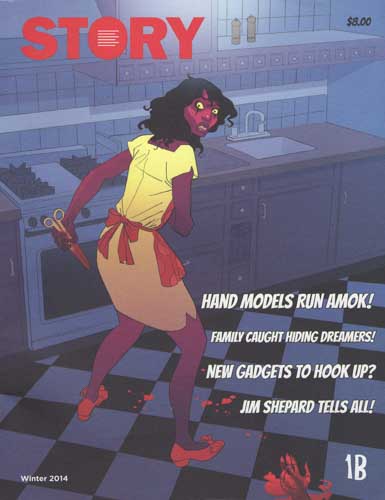Story – 2014
The inaugural issue of this stellar new litmag “devoted to stories of all kinds, focusing on a single theme each issue” is a double steal. To access Side B from Side A, readers have to turn the volume (the same size and shape as The Believer and Creative Nonfiction, two similarly innovative mags) over and upside-down. In either side, said reader will find herself “innovated” and turned more than a bit upside down, on purpose and with undeniable, delighted affirmation. I can imagine a cadre of new readers sitting around a table drinking wine and rehashing this issue with high gratification deep into the night.
The inaugural issue of this stellar new litmag “devoted to stories of all kinds, focusing on a single theme each issue” is a double steal. To access Side B from Side A, readers have to turn the volume (the same size and shape as The Believer and Creative Nonfiction, two similarly innovative mags) over and upside-down. In either side, said reader will find herself “innovated” and turned more than a bit upside down, on purpose and with undeniable, delighted affirmation. I can imagine a cadre of new readers sitting around a table drinking wine and rehashing this issue with high gratification deep into the night.
Travis Kurowski, who edited Paper Dreams (Atticus Books), last year’s exploration of the current state of the lit mag world, has written the editorial introduction for both sides, asserting that no other lit mag is dedicated solely to story. 1A’s “innovator” and editorial co-writer is Vito Grippi; he also gets credit for “Innovation” on 1B, with guest editor Ryan Britt. Britt, whose credits wander incandescently through mainstream, academic, sci-fi, and speculative writing, writes a blog for sci-fi publishing house TOR. Kurowski has chosen his collaborators (and his contributors) with a brilliant eye. Future issues should be wondrous.
The theme of Story 1A is “Inside the Box.” On its cover, four antiqued picture frames house black-and-white photos from other times, each with one surprising out-of-character color figure “inside the box” in the literal sense, but not at all if we’re speaking metaphorically. Story 1B’s theme is “Ray Guns Tucked into Tweed Jackets.” The twisted, shell-shocked housewife on the cover, designed by cartoonist Mike Hawthorne, holds in her left hand a blood-stained pair of scissors, while in the lower right corner of the picture, the hand of the person she’s just murdered drips gore onto the kitchen floor. An eerie midnight blue soaks the grisly scene, so that her skin is purple, her yellow housedress the same lurid hue as the desperate eyes she casts over her shoulder as if to wish us far, far away. It illustrates James Hannaham’s story “High Five,” 1B’s cover story. The second-person accusation/confession recounts the trials of Tiffany, a “parts model,” whose egocentric “part,” Tatiana, has driven the Tiffany parts to—well, gore and destruction. In an interview with Hannahan, one of the many high points of the issue, Kurowski asks Hannaham what parallels he sees between what he writes now and what he was “reading or doing as a kid.” Hannaham says:
Walter Murch [the film editor who worked with Coppola for many years] . . . said . . . the people who are doing something closer to what they wanted to be doing when they were 13 years old are the happiest people he knows . . . if I’d given a list of my titles to me at 13 and said, here’s what you’re going to be writing, I would have been thrilled.
The rollicking variety and sheer sparkling quality of this issue persuade that everyone involved in Story is doing what they’d have been thrilled with then, and ever since.
Also from side B, Allegra Frazier’s “Dreamers, Again” evokes an awful space between a real estate buyer’s high and a futuristic plague lying in wait in the walls. Two poems, Jason McCall’s “Superman Watches Lois Lane Pull Weeds” and Krista Franklin’s “Platform, Position & Possibility: Magneto Speaks,” speculate darkly on the underside of superheroism. And the reprint of Benjamin Percy’s 2011 Gulf Coast story, “The Cold Boy,” is ominously paced, suspenseful and horrifying throughout.
Chimamanda Ngozi Adichie’s “The Danger of a Single Story” forms the issue’s central chiasm, in Spanish in 1B side, in English in 1A. Same story (an essay can also be a story—I plan to use this one in both my Creative Nonfiction Writing and Intro to Theory classes later this year). Stunningly good.
The rest of 1A is as terrific inside the box as 1B is highbrow speculative. Andrew Malan Milward’s story “Hard Feelings” evokes the tension between siblings differently caught in the racial activism of the sixties in the South. I’ll distribute Randi Shedlosky-Shoemaker’s “Narrative Persuasion” in the same two classes I’ve already mentioned, as she succinctly reviews academic studies examining the role of narrative in rhetorical persuasion. Ditto “Special Notice” in 1B, by the way, an ironic (fictional) announcement for a workshop whose goal is to “understand the role of narrative in security contexts . . .”
“On Brevity” by David Shields rounds out the metanarrativity of this issue, but the “Convicted Minimalist Portfolio” that forms the middle third of 1A (with pieces by Frederick Barthelme, Steven Barthelme, Mary Miller, Kim Chinquee, and others), along with a graphic short by MariNaomi, an excerpt from Marco Roth’s memoir The Scientists, and three poems by Jeremy Lespi, demonstrate the glorious variety of contemporary “story.” Together they convince me handily: this magazine is at the forefront of whatever happens there next.
[www.storymagazine.org]





